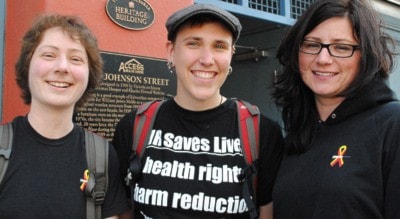It’s been three years since the Victoria Needle Exchange closed on Cormorant Street. Foggy statistics make it hard to know just how many people have gone without services since then, but one thing is certain: the vacant lot has left a pockmark in the city’s landscape, with little hope in recovery until awareness is brought back.
That’s the message AIDS Vancouver Island (AVI) hopes Victorians will heed, and part of the reason that June 1 has been officially named Harm Reduction Awareness Day in B.C.
AVI, along with other service providers, hosted an awareness day event in Centennial Square on June 1, offering the public information on harm reduction, HIV, hepatitis C and other health issues that come with the territory. Vancouver Island Health Authority (VIHA) Street Nurses were available from 11 a.m. to 1 p.m. to answer questions about testing.
Members of AVI worked with Victoria City councillor Marianne Alto as well as the province to mark out the event. June 1 comes just weeks after the Supreme Court of Canada was hearing arguments to determine the fate of Vancouver’s supervised injection site, Insite. Ten out of 11 interveners spoke at length about the value of such critical health services.
“What the country has learned from Insite is that harm reduction services, such as supervised consumption sites, have the potential to save money, save lives, decrease public disorder associated with illegal drug use, and help people to access treatment,” says Katrina Jensen, executive director of AVI.
“Harm reduction can be a win-win for people who need services and the community at large. This day is about celebrating this fact with the community.”
Alto, who has been an advocate for a Victoria needle exchange site in the past, says that awareness is the first step in creating solutions.
“Marking Harm Reduction Awareness Day in Victoria reminds us that our community still needs a range of integrated, collaborative harm reduction services,” she says. “We’ve had some success, but there’s much more to do, and the city looks forward to doing its part, working with VIHA and other community partners.”
For the past three years, those in need of services have been lacking essential rights to health, according to Erin Gibson, manager of Street Outreach Service with AVI. She says not having access to those services hurts the entire community.
“A lot of people who use drugs are invisible. We’re really missing having a regular place for people to come to and connect and build trust,” Gibson says. “By offering these tools, we’re saying what’s most important is people’s health.”
Gibson says harm reduction services have never pushed the “must-quit” agenda, but the real emphasis is placed on getting to the root of why someone makes the choices they do, and discovering the tools they need to make the choices they want.
“There is a real stigma around choice and making the ‘right’ and ‘wrong’ decision, but everyone has a right to their health,” she says.
Since the site closed on May 31, 2008, nurses with the Street Outreach Van have done what they could to make up for the loss. Still, the need far outweighs the services available.
While AVI and others have aggressively advocated for the Yes-In-My-Backyard approach, the former Cormorant lot has remained vacant.
Event organizer Andrea Langlois, AVI manager of communications, says that, as others have pointed out, when a Starbucks line gets too long, people don’t close down the coffee shop — they build another.
“We want to give people the opportunity to come down and learn about why harm reduction works … Without this service, there remains unequal access to health services in our community and we’d like the community’s support to correct this imbalance,” she says.
“Harm reduction, treatment, public health and public order can and do go hand in hand.” M
For more information, visit avi.org/harmreductionawarenessday2011
